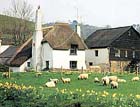Are period properties sustainable?
Many owners of period properties are concerned about their energy efficiency. Projectbook has some hints for owners considering their options


There is little doubt that upgrading the energy efficiency of existing properties is hugely important, especially when one considers that 27% of total CO2 emissions in the UK are attributed to the energy requirements of homes. But can a period home ever be considered sustainable? Happily, by their very nature, older buildings are not necessarily less sustainable or energy efficient than new ones. Compared to 20th-century construction, many are built with natural, local materials. They have high thermal mass due to their thick walls and small windows which helps them stay warmer in winter and cooler in summer. However, further improving the energy efficiency of an older building can cause damage if it's not done properly.
Insulation is the first and most important step in improving thermal efficiency and cutting energy needs, but if inappropriate techniques and materials are used the consequences can be disastrous. Buildings built before around 1919 need to ‘breathe' to function properly and non-breathable insulation solutions applied to walls can trap moisture and do incalculable damage long term. Equally, whilst being airtight is good in energy conservation terms, controlled ventilation is vital to avoid condensation and mould growth which may lead to heath problems for the building and its occupants. Aside from insulation, many property owners are considering using alternative energy to hear their homes. When it comes to considering solar thermal and photovoltaics, aesthetics are a key issue with period properties - it's also worth remembering that some systems require internal space for the associated technical kit and this can be difficult in period properties.
* For more stories like this every week subscribe and save Adopting the conservation approach to the repair of old buildings is inherently sustainable when you consider the embodied energy of existing buildings: the energy used during the manufacture and transportation of the materials employed to build them in the first place. ‘New Tricks with Old Bricks', a study published by the Empty Homes Agency, supports the view that refurbishing existing homes and converting empty property into new homes can yield CO2 reductions by preventing emissions from embodied energy that would arise from new build.
The study compared the CO2 given off in building new homes and creating new homes through refurbishing old properties. The findings showed that re-using empty homes could make an initial saving of 35 tonnes of CO2 per property by removing the need for the energy locked into new build materials and construction. Well-insulated new homes eventually make up for their high embodied energy costs through lower operational CO2 but it takes several decades - in most cases more than 50 years. Ultimately, of course, sustainability is not just about what goes on inside. Buildings help shape communities and old buildings are especially good at doing this through their design and interaction with spaces. People who enjoy where they live and find their surroundings help them mix with their neighbours generally feel safe and happy and this in turn helps make sustainable neighborhoods. Contacts English Heritage www.climatechangeandyourhome.org.uk Mark Hines Architects www.markhines.co.uk SAVE www.savebritainsheritage.org The Empty Homes Agency www.emptyhomes.com Roger Hunt, co-author of Old House Handbook, can be contacted via twitter.com/huntwriter
James Mott is managing director and founder of Projectbook
Exquisite houses, the beauty of Nature, and how to get the most from your life, straight to your inbox.
Country Life is unlike any other magazine: the only glossy weekly on the newsstand and the only magazine that has been guest-edited by His Majesty The King not once, but twice. It is a celebration of modern rural life and all its diverse joys and pleasures — that was first published in Queen Victoria's Diamond Jubilee year. Our eclectic mixture of witty and informative content — from the most up-to-date property news and commentary and a coveted glimpse inside some of the UK's best houses and gardens, to gardening, the arts and interior design, written by experts in their field — still cannot be found in print or online, anywhere else.
